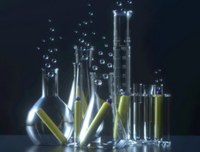
An actual "solar plant" producing, on the one hand, clean fuel (like hydrogen) and on the other, a series of chemical compounds which can be used in drug production. This is made possible by a sun-powered man-made mechanism, which was developed by a research team from the University of Bologna and the Technion - Israel Institute of Technology.
This system exploits a nano-structured semi-conductor whose levels of solar-energy conversion into chemical energy are very close to those necessary for applications on an industrial scale. Details about this system were published in a research paper on the Nano Energy journal. "This is a fundamental step towards men-made highly efficient photosynthesis systems able to liven up the solar industry of the future", says Unibo professor and research coordinator Giacomo Bergamini.
Researchers started from a material that presented a nanometric structure of platinum, cadmium sulfide and cadmium selenide, and successfully tested the possibility of producing hydrogen and, at the same time, high-added value chemical compounds which are usable in the pharmaceutical industry. They did all this by exploiting a solar-powered man-made photosynthesis mechanism: a stable and highly efficient system, as it turns out. "Getting this to an industrial scale does not seem impossible anymore: the efficiency level we obtained from the system we developed is really close to the cut-off point that is required for starting an technological transfer process", says Amedeo Agosti, Unibo researcher and among the scholars in this study.
This is one of the results of Phototrain, a European research project led by the University of Bologna, which provides young researchers with ambitiously multidisciplinary training opportunities in the field of the conversion of solar power into chemical products. "The Alma Mater boasts a great tradition of great scholars and results in this field", reminds professor Bergamini. "Starting with the results obtained by Giacomo Ciamician, who, more than 100 years ago, forecasted the end of fossil fuels in favor of solar energy and to whom now the department of Chemistry is dedicated".
Moreover, from the point of view of the communication, this new study obtained a number of public acknowledgments. The "Graphical Abstract" of the research paper of this study won the photographic contest organized by the Sunrise Consortium. This award allowed Amedeo Agosti to present the results of this research in Bruxelles during an event about the macro-areas which will be the main components of the next European scientific research actions.
The title of the study is “Photosynthetic H2 generation and organic transformations with CdSe@CdS-Pt nanorods for highly efficient solar-to-chemical energy conversion” and was published on the Nano Energy journal. Author of this study is Amedeo Agosti (researcher) supervised by professor Giacomo Bergramini, both from the department of Chemistry "Giacomo Ciamician" of the University of Bologna. Scholars from the Technion - Israel Institute of Technology also participated in the study.
